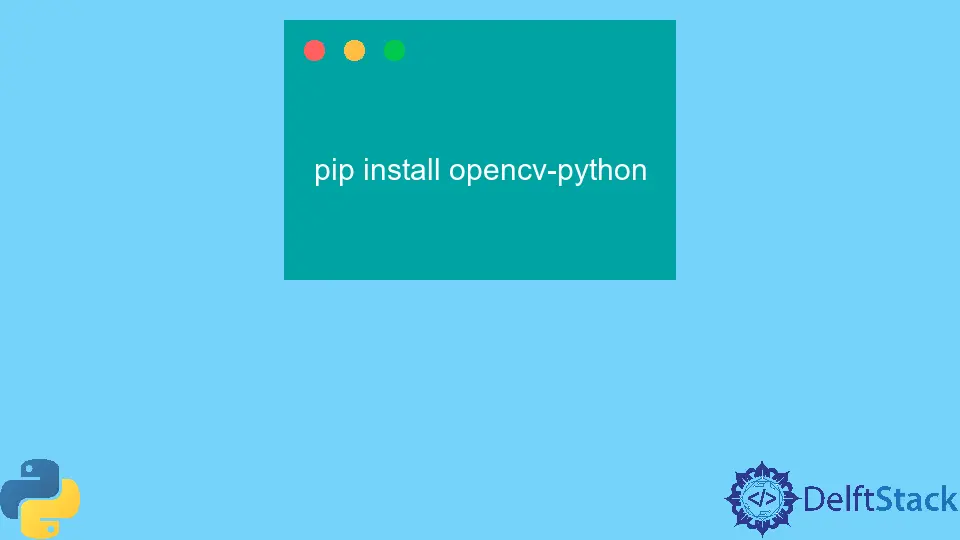How to Install OpenCV in Python
- Method 1: Installing OpenCV using pip
- Method 2: Installing OpenCV using conda
- Method 3: Building OpenCV from Source
- Conclusion
- FAQ

OpenCV, or Open Source Computer Vision Library, is a powerful tool for image processing and computer vision tasks. Whether you’re looking to build a simple image manipulation project or delve into advanced machine learning applications, installing OpenCV in Python is a crucial first step.
This tutorial will guide you through the installation process, ensuring you have everything set up correctly to start your journey with OpenCV. We’ll cover various methods for installation, including the use of pip and conda, making it easy for you to choose the best approach for your needs. Let’s dive in!
Method 1: Installing OpenCV using pip
One of the most straightforward ways to install OpenCV in Python is by using pip, Python’s package manager. This method is popular among developers due to its simplicity and efficiency. Here’s how to do it:
First, ensure you have Python and pip installed on your system. You can check this by running the following commands in your terminal or command prompt:
python --version
pip --version
If both are installed, you can proceed with installing OpenCV. Open your terminal and run the following command:
pip install opencv-python
This command will fetch the latest version of OpenCV and install it along with its dependencies. Depending on your internet speed, the installation might take a few moments.
Output:
Collecting opencv-python
Downloading opencv_python-4.x.x-cp39-cp39-manylinux1_x86_64.whl (50.3 MB)
|████████████████████████████████| 50.3 MB 1.2 MB/s
Installing collected packages: opencv-python
Successfully installed opencv-python-4.x.x
Once the installation is complete, you can verify it by opening a Python shell and importing the library:
import cv2
print(cv2.__version__)
Output:
4.x.x
This will display the version of OpenCV you have installed, confirming that everything is set up correctly. Using pip is a great option for those who want a quick and easy installation process.
Method 2: Installing OpenCV using conda
If you’re using Anaconda or Miniconda, installing OpenCV can be done seamlessly through conda. This method is particularly beneficial if you’re managing multiple environments or require specific versions of libraries. Here’s how to install OpenCV using conda:
First, open your Anaconda prompt or terminal. To create a new environment (optional but recommended), you can run:
conda create -n opencv_env python=3.9
Activate the new environment with:
conda activate opencv_env
Now, you can install OpenCV by executing the following command:
conda install -c conda-forge opencv
This will pull the OpenCV package from the conda-forge channel, which is a community-maintained repository.
Output:
Solving environment: done
## Package Plan ##
environment location: /path/to/anaconda3/envs/opencv_env
added / updated specs:
- opencv
The following NEW packages will be INSTALLED:
opencv pkgs/main/linux-64::opencv-4.x.x-h3e4c0f4_0
After the installation completes, you can verify it similarly to the pip method. Open Python in your terminal and run:
import cv2
print(cv2.__version__)
Output:
4.x.x
Using conda not only simplifies package management but also helps avoid dependency conflicts, making it a preferred choice for many data scientists and developers.
Method 3: Building OpenCV from Source
For advanced users or those who need specific customizations, building OpenCV from source can be an excellent option. This method allows you to enable or disable certain features according to your project requirements. Follow these steps to build OpenCV from source:
First, ensure you have the required dependencies installed. You’ll need CMake, Git, and other libraries. On Ubuntu, you can install them using:
sudo apt-get update
sudo apt-get install build-essential cmake git pkg-config libjpeg-dev libtiff-dev libjasper-dev libpng-dev
Next, clone the OpenCV repository:
git clone https://github.com/opencv/opencv.git
cd opencv
Create a build directory and navigate into it:
mkdir build
cd build
Now, configure the build with CMake:
cmake -D CMAKE_BUILD_TYPE=Release -D CMAKE_INSTALL_PREFIX=/usr/local ..
Finally, compile and install OpenCV:
make -j$(nproc)
sudo make install
Output:
[ 99%] Built target opencv_core
[100%] Built target opencv_imgproc
[100%] Built target opencv_highgui
...
Installation successful
Once the installation is complete, you can check if OpenCV is working by running the same Python commands as before:
import cv2
print(cv2.__version__)
Output:
4.x.x
Building from source can be time-consuming, but it gives you complete control over the installation and the features you want to include. This is ideal for developers working on specialized computer vision projects.
Conclusion
Installing OpenCV in Python is a fundamental step for anyone interested in image processing and computer vision. Whether you choose to use pip for a quick setup, conda for better environment management, or opt to build from source for custom configurations, each method has its advantages. By following the steps outlined in this guide, you’ll be well on your way to leveraging the power of OpenCV in your Python projects. Happy coding!
FAQ
-
What is OpenCV?
OpenCV is an open-source computer vision library that provides tools for image processing and machine learning. -
Can I use OpenCV with Python 2?
OpenCV supports Python 3.x. It is recommended to use Python 3 for the latest features and updates. -
What are the common applications of OpenCV?
OpenCV is used in various applications, including facial recognition, object detection, image stitching, and real-time video processing. -
Is OpenCV free to use?
Yes, OpenCV is free to use under the open-source Apache 2 License. -
How can I uninstall OpenCV?
You can uninstall OpenCV using pip with the commandpip uninstall opencv-pythonor using conda withconda remove opencv.
Manav is a IT Professional who has a lot of experience as a core developer in many live projects. He is an avid learner who enjoys learning new things and sharing his findings whenever possible.
LinkedIn